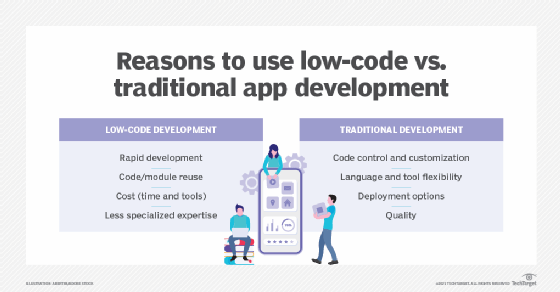Comparing low-code vs. traditional development
The lines between low-code and traditional development aren't always clear. Compare the pros and cons of each approach to judge which makes sense for your organization.
In general, a low-code approach enables developers to write fewer lines of code than they would through traditional application development. But, while it's easy to treat low-code development and traditional development as an either/or proposition, the reality is more complex.
Low-code and traditional approaches to programming have some distinct differences. Each has benefits and drawbacks, but they often overlap within the same workflows and can be integrated into an effective and efficient development strategy.
Read on for more about the differences between low-code and traditional application development practices, the benefits and drawbacks of each, and how developers can integrate a low-code development approach with traditional development.
What is low-code development?
Low-code development is an approach whereby a developer implements some elements of an application using precoded modules, often selected through a drag-and-drop interface, to build desired functionality. In a low-code approach, developers generally write fewer lines of code than they do with traditional application development, although usually with some custom coding to tweak modules or customize the relationships between them.
The main and most obvious benefit of low-code development, especially for seasoned programmers, is that it's fast. Prebuilt modules reduce the time to implement application functionality, so development teams can focus on tasks that require more originality or that have higher priority for the business. Low-code development also can help developers integrate an app with an external platform without learning all the ins and outs of that external platform.
How do low-code vs. traditional development differ?
Low-code development differs from traditional development in several key ways.
| Low-code development | Traditional development | |
| Cost | Medium or low, due to lower reliance on high-paid professional developers. | High, due mainly to the high staff resources required for development. |
| Control | Low, because a preset level of abstraction limits developers' configuration and customization options. | High, because developers can choose their level of abstraction or work directly with source code to implement custom features as desired. |
| Skills required | Medium to low, thanks to drag-and-drop coding interfaces. | High, because it requires advanced coding skills and knowledge of software development tools and processes. |
| Speed | High, because users can take advantage of prebuilt components. | Low, because code must be implemented from scratch. |
| Security | Varies -- high when modules are configured to be secure by default, low because source code is buried under abstractions, making audits difficult. | Varies -- high when developers follow secure coding practices, low when mistakes lead to security oversights with no built-in controls to correct them. |
| Compliance | Medium, because it might pose challenges if modules or deployment options don't conform with compliance needs or integrate smoothly with systems that handle regulatory procedures. | Medium to high, because it is easier to meet complex or bespoke compliance requirements -- provided developers adhere to them -- developers can customize their environment to integrate with tools that handle regulatory procedures. |
| Flexibility | Low, because low-code development platforms limit developers to compatible languages and tools and carry the risk of vendor lock-in. | High, because traditional developers can use any platform, language or tool to create custom software tailored to their specific needs. |
Benefits and drawbacks of low-code development
The benefits of low-code development include the following:
- Speed. Programmers can build apps faster using a low-code approach because it eliminates some manual programming work, thanks to features such as prebuilt components, automation, templates, visual coding and drag-and-drop interfaces.
- Reduced cost. Low code streamlines development processes, which results in faster time to market, reducing costs. Because low-code development is faster, it can reduce total costs for the business.
- Reuse. Low-code modules are reusable and shareable between apps, although this might be restricted to the same low-code platform.
- Ease of integration. Low-code modules can integrate with most SaaS products, including ERP and CRM systems. This improves the agility of the tech stack.
- Alignment of development with business value. Prebuilt components and the visual aspects of low-code tools facilitate a focus on business needs.
However, there are some drawbacks of low code, such as the following:
- Lower performance. Low-code apps might not perform as well or be as reliable as well-designed apps created using a traditional approach. Autogenerated code is typically designed to support a wide variety of platforms and use cases, rather than a team's specific deployment environment or application architecture.
- Less customization. Low-code platforms offer less opportunity to customize an overall application or control how it runs. This can complicate integration with legacy systems, especially those with complex end-to-end workflows.
- Fewer deployment options. Some low-code platforms enable developers to deploy applications only to certain platforms, such as specific clouds.
- Insufficient skills. Low-code techniques typically require at least some manual coding experience and a fundamental understanding of application design and functionality. Some low-code IDEs can also be complex. These might be beyond the capabilities of internal users and force an organization to rely on expert programmers and contractors.
- Lack of support for regulatory compliance. Low-code tools are mostly SaaS products and might not provide organizations with access to the information they need to meet management requirements for development, testing and documentation quality for regulated software.
Benefits and drawbacks of traditional development
Traditional application development processes are a cornerstone of enterprise IT departments, with benefits that include the following:
- Greater control. Developers have the greatest degree of control over how to write code and structure applications.
- Flexibility. Traditional development can be accomplished using virtually any programming language and development platform, which facilitates scalability and reduces performance issues when adding features to a mature application.
- Deployment anywhere. Apps developed using a traditional approach can be deployed to whichever destinations developers choose to support. This can be especially important for mobile app development.
- Regulatory compliance. With traditional development, organizations can more effectively integrate with data and systems to ensure they meet the specific requirements for regulated software.
There are some major drawbacks of traditional development:
- More time-consuming. Manual programming takes more time and effort than autogenerated code from low-code tools. It also takes longer to manually tweak code to support multiple platforms and build interfaces between applications and services.
- Specialized skills. Traditional development might require more expertise with a certain programming language or development platform. This is especially true with legacy applications since the original developers with the appropriate platform and coding knowledge might no longer be with the organization.
When to use low-code development: Common use cases
Below are some common use cases where low-code approaches offer the most value:
- Integrations. Low-code tools can help developers integrate an app built with external tools or platforms.
- Simple websites. There is rarely sufficient reason to handwrite HTML, PHP and CSS code for a simple website that consists mostly of static content.
- Business analytics. A low-code approach is often ideal to build dashboards or reporting tools to support business analytics. Many ERP platforms offer integrated low-code tools.
- Business processes. Similarly, apps that support simple business processes, such as customer data collection or vendor contract approvals, are good candidates for low-code development. Low-code integrations in business process management platforms make building these apps accessible, even for people who aren't professional coders.
When to use traditional development, not low code
To get the most out of low code, it's equally important to know when traditional development is a better approach. Consider the following factors:
- Security. Low code is not inherently insecure, but it can be difficult to ensure that low-code apps are developed according to strict security standards. They might also be more difficult to audit because source code is buried under the low-code abstractions.
- Performance. Low-code apps are unlikely to deliver the highest degree of performance. For top performance, you might need to optimize every line of code, which requires a traditional development approach.
- Maintainability. If the low-code tools used to develop an app are discontinued by their vendor, maintenance over the long term becomes a challenge.
- Lock-in. A dependence on low code might put developers at higher risk of being locked into a particular low-code platform and its ecosystem. They might be able to deploy only to the environments the platform supports or encounter difficulties migrating their codebase to a different vendor's platform.

How to use low-code and traditional development together
The best way to take advantage of low code is not to choose between a low-code approach or traditional development. Instead, strike the right balance between the two strategies, and determine where it makes most sense to incorporate low-code approaches into your workflows.
Most enterprise developers have long implemented low-code techniques in certain parts of their workflows. If an IDE auto completes lines of code or automatically fills in variable names, for example, that functionality approximates low-code development, although traditional development tool vendors rarely promote it that way. External modules or third-party APIs that integrate functionality into an application are also akin to low-code programming.
Content management platforms, such as WordPress and Drupal, also blur the line between traditional development and low code because they support both techniques. You can develop basic websites on these platforms with little custom coding or create a simple website with just a few points and clicks and no coding at all. Meanwhile, some heavy-duty e-commerce sites and media hubs build websites on these platforms with extensive original coding.
Low code vs. no code
Low-code and no-code platforms both automate and streamline development of software applications and functionality, using tools that push the details of development, testing and deployment behind the scenes. While similar, these development approaches are distinct in ways that boil down to two areas: functionality and ease of use.
A low-code approach still requires some minimal level of coding and knowledge of a programming language. An experienced enterprise developer might use low code for certain tasks, such as integrations.
No code means just that: The code is abstracted away entirely. Less experienced developers or line-of-business users, sometimes called citizen developers, can use no-code platforms to build simple apps and websites, although enterprise developers might use no-code as well for simple tasks.
From a technology perspective, many platforms can be used for either low-code or no-code work, typically through drag-and-drop interfaces and a model-driven development approach. However, even with no-code work, professional developers might be needed to ensure the new app or functionality properly integrates with specific processes and systems.
Most development strategies are best suited to a mix of traditional development and low-code approaches. Although various platforms are marketed specifically for low-code development, they likely do not fully meet an organization's development needs on their own.
Gerie Owen is QA engineering manager at Roobrik. She is a conference presenter and author on technology and testing topics, as well as a certified Scrum master.
Chris Tozzi is a freelance writer, research adviser, and professor of IT and society. He has previously worked as a journalist and Linux systems administrator.







